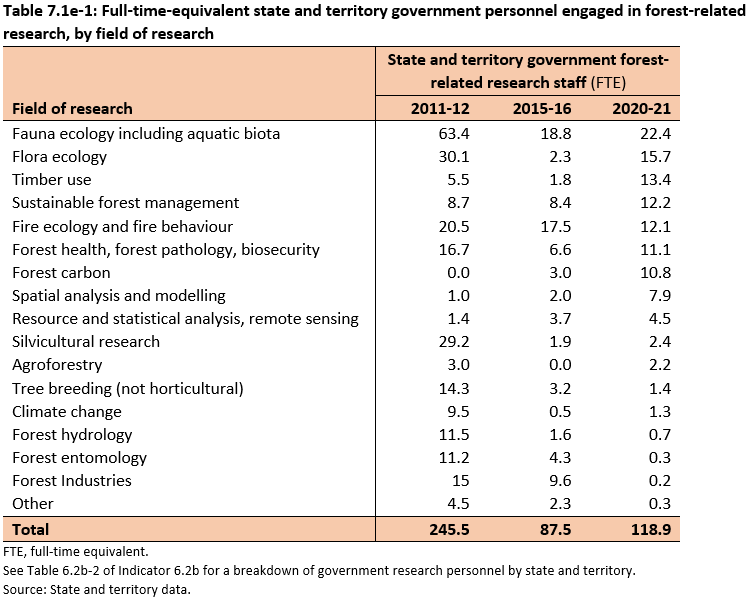This indicator reports on the scientific understanding of Australian forest ecosystem characteristics and functions needed to underpin sustainable forest management. Research, inventory and the development of assessment methodologies provide the basis for sustainable forest management.
This is the Key information for Indicator 7.1e, published October 2024.
- Australia’s capacity to conduct and apply research and development to improve the scientific understanding of forests and delivery of forest products has followed a declining trend due to changes in funding and delivery models by state and territory governments.
- The total number of forest-related researchers employed by state and territory agencies was reported as 118.9 full-time-equivalent (FTE) staff for 2020-21, an increase from the 87.5 FTE staff reported for 2015 16, but less than half of the 245.5 FTE staff reported for 2011-12.
Australia has developed a comprehensive knowledge-base of the ecological characteristics and functions of its unique forest ecosystems, based on more than 100 years of scientific research and monitoring in a wide range of geographic and climatic areas, to underpin sustainable forest management. However, Australia’s capacity to conduct and apply research and development to improve the scientific understanding of forests and delivery of forest products has followed a declining trend due to changes in funding and delivery models by state and territory governments.
The total number of forest-related researchers employed by state and territory government agencies was reported as 118.9 full-time-equivalent (FTE) staff for 2020-21, increasing from the 87.5 full-time-equivalent (FTE) staff reported for 2015-16, but less than half of the 245.5 FTE reported for 2011-12 (Table 7.1e-1). The FTE values reported here are approximate and with low confidence for trends over time due to the difficulty of confirming the direct relevance of some research to forests. These values only reflect capacity with respect to human resources and not the extent to which human capacity may have been replaced by improved technologies.
Between 2015-16 and 2020-21, state and territory government research staff numbers increased in most fields of forest-related research, but between 2011-12 and 2020-21 staff numbers decreased substantially in most fields of forest-related research (Table 7.1e-1). For a breakdown by state and territory of government research personnel, see Table 6.2b-2 of Indicator 6.2b.
Click here for a Microsoft Excel workbook of the data for Table 7.1e-1.
Carnegie et al. (2022) reported a 50% reduction in forest health and biosecurity technical expertise between 2000 and 2020, and anticipate a further halving by 2035 based on knowledge of current personnel, likely future retirements and lack of recruitment.
Earlier studies investigating employment in forestry and forest products research and development (Turner and Lambert 2016) identified 276 researchers and technicians employed nationally in 2012-13. This represented a steady decline in research staff since about 1990, from a peak of 794 full-time-equivalent personnel in 1985. These values were calculated from a series of surveys that collected data on forestry and forest products research and development capacity over the period 1981-82 to 2012-13. The expertise of each researcher was not recorded for these surveys, but discussions with employing organisations indicated that there has been a greater decline in some areas of research, such as forest health, silviculture and forest hydrology, compared to others.
Over the period 2017 to 2024, Australia's capacity to conduct and apply forest research and development nationally has been coordinated and delivered through several organisations, including:
- the Australian Bureau of Agricultural and Resource Economics and Sciences (ABARES)
- the Commonwealth Scientific and Industrial Research Organisation (CSIRO)
- Forest and Wood Products Australia (FWPA)
- Australian Forest and Wood Innovations (AFWI) (previously the National Institute for Forest Products Innovation)
- the Terrestrial Ecosystem Research Network (TERN)
- the Long Term Ecological Research Network
Australia also supported international forest research through the Australian Centre for International Agricultural Research (ACIAR) over the period 2017 to 2024.
See Supporting information to Indicator 7.1e for descriptions of the national forest research and development organisations.
Carnegie AJ, Tovar F, Collins S, Lawson SA, Nahrung HF (2022). A Coordinated, Risk-Based, National Forest Biosecurity Surveillance Program for Australian Forests, Frontiers in Forests and Global Change 4:756885. 10.3389/ffgc.2021.756885
Turner J, Lambert M (2016). Changes in Australian forestry and forest products research for 1985–2013, Australian Forestry 79(1):53–58. 10.1080/00049158.2015.1095853
Further information
- National forest research and development organisations
- State and territory forest-related research and development capacity
- University-based research capacity
- Case study: Warra Long-Term Ecological Research site

